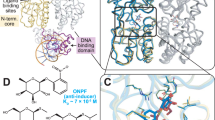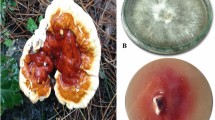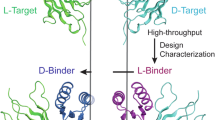Abstract
The lac repressor, a tetrameric protein of identical subunits [molecular weight (MW) 4 × 38,500], interacts specifically with the lac operator, preventing the expression of the structural genes of the lac operon 1,2 . The presence of an inducer (such as isopropyl-β-D-thiogalactoside; IPTG) which binds to the repressor, prevents operator binding by lowering the association constant by a factor of 103 (ref. 3). Genetic and biochemical analysis have shown that the major part—if not all—of the binding site for the lac operator is located in the 60 N-terminal residues of the protein1,4,5. In certain conditions, limited trypsinolysis of the protein yields four N-terminal ‘headpieces’ each containing 51 or 59 residues, and a tetrameric core with full inducer binding activity 4,5. It was shown recently that this headpiece is able to bind nucleic acids, and interacts with the lac operator 6, giving the same pattern of sensitivity with respect to the methylation of the bases as does the intact repressor7. We are studying the interaction of lac repressor with DNA by neutron scattering using contrast variation and discuss here measurements on the protein, its tryptic core and their complexes with IPTG. Our results demonstrate that the headpieces are located far (67 ± 10 Å) from the centre of mass of a somewhat elongated core, and that the inducer does not significantly change the radius of gyration of the protein.
This is a preview of subscription content, access via your institution
Access options
Subscribe to this journal
Receive 51 print issues and online access
$199.00 per year
only $3.90 per issue
Buy this article
- Purchase on SpringerLink
- Instant access to full article PDF
Prices may be subject to local taxes which are calculated during checkout
Similar content being viewed by others
References
Müller-Hill, B. Prog. Biophys. molec. Biol. 30, 227–252 (1975).
Bourgeois, S. & Pfahl, M. Adv. Protein Chem. 30, 1–99 (1976).
Barkley, M. D., Riggs, A. D., Jobe, A. & Bourgeois, S. Biochemistry 14, 1700–1712 (1975).
Platt, T., Files, J. G. & Weber, K. J. biol Chem. 248, 110–121 (1973).
Files, J. G. & Weber, K. J. biol. Chem. 251, 3386–3391 (1976).
Geisler, N. & Weber, K. Biochemistry 16, 938–943 (1977).
Ogata, R. T. & Gilbert, W. Proc. natn. Acad. Sci. U.S.A. 75, 5851–5854 (1978).
Guinier, A. & Fournet, G. in Small-angle Scattering of X Rays (Wiley, New York, 1975).
Jacrot, B. Rep. Prog. Phys. 39, 911–953 (1976).
Farabaugh, P. L. Nature 274, 765–769 (1978).
Serdyuk, I. N., Zaccaï, G. & Spirin, A. S. FEBS Lett. 94, 349–352 (1978).
Satre, M. & Zaccaï, G. FEBS Lett. 102, 244–248 (1979).
Ramstein, J., Charlier, M., Maurizot, J. C., Szabo, A. G. & Hélène, C. Biochem. biophys. Res. Commun. 88, 124–129 (1979).
Platt, T., Files, J. G. & Weber, K. J. biol. Chem. 248, 110–121 (1973).
Alexander, M. E., Burgum, H. A., Noall, R. A., Shaw, M. D. & Matthews, K. S. Biochem biophys. Acta 493, 367–379 (1977).
Ogata, R. T. & Gilbert, W. J. molec. Biol (in the press).
Chandrasekaran, R., Jardetzky, T. S. & Jardetzky, O. FEBS Lett, 101, 11–14 (1979).
Buck, F., Rüterjans, H. & Beyreuther, K. FEBS Lett. 96, 335–338 (1978).
Wade-Jardetzky, N. et al. J. molec. Biol. 128, 259–264 (1979).
Steitz, T. A., Richmond, T. J., Wise, D. & Engelman, D. Proc. natn. Acad. Sci. U.S.A. 71, 593–597 (1974).
Ohshima, Y., Horiuchi, T. & Yanagida, M. J. molec. Biol. 91, 515–519 (1975).
Geisler, N. & Weber, K. Proc. natn. Acad. Sci. U.S.A. 73, 3103–3106 (1976).
Kania, J. & Brown, T. Proc. natn. Acad. Sci. U.S.A. 73, 3529–3533 (1976).
Müller-Hill, B., Beyreuther, K. T. & Gilbert, W. Meth. Enzym. 21 part D, 483–487 (1974).
Author information
Authors and Affiliations
Rights and permissions
About this article
Cite this article
Charlier, M., Maurizot, J. & Zaccai, G. Neutron scattering studies of lac repressor. Nature 286, 423–425 (1980). https://doi.org/10.1038/286423a0
Received:
Accepted:
Issue date:
DOI: https://doi.org/10.1038/286423a0
This article is cited by
-
Lac repressor — Lac operator complexes
European Biophysics Journal (1987)
-
Recognition of base sequences by regulatory proteins in procaryotes and eucaryotes
Bioscience Reports (1981)



